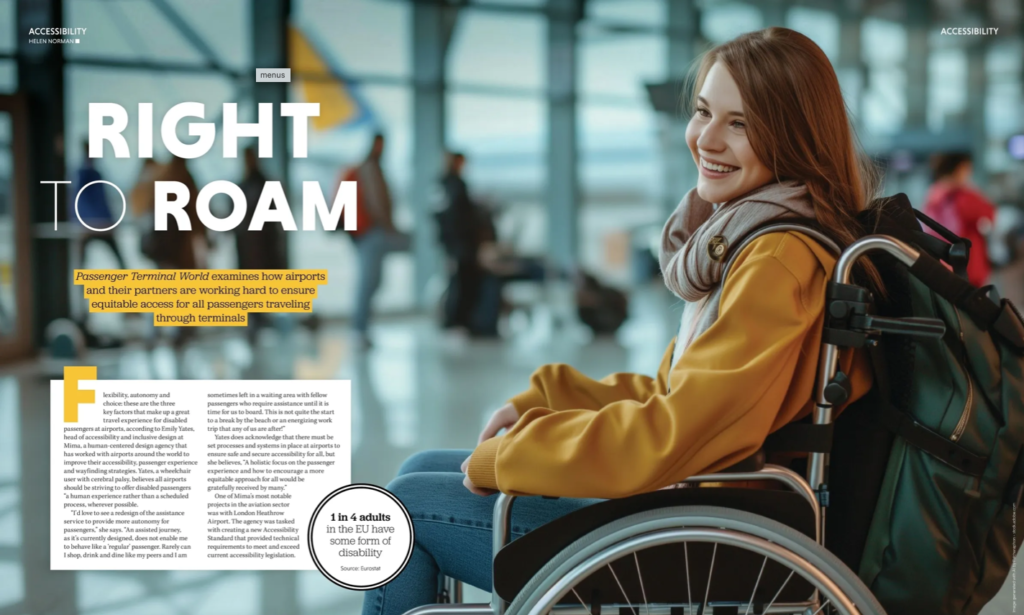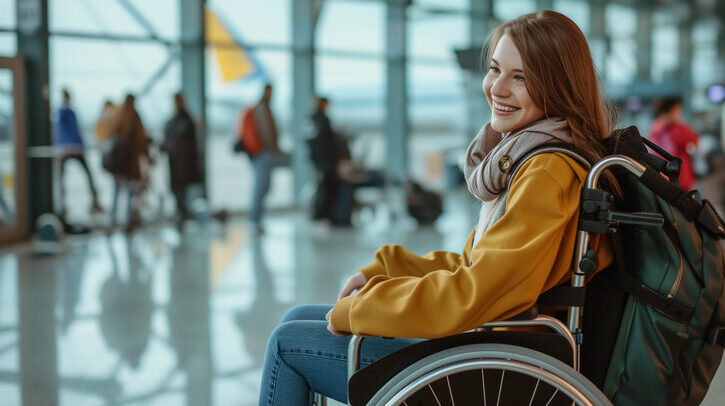Flexibility, autonomy and choice: these are the three key factors that make up a great travel experience for disabled passengers at airports, according to Emily Yates, head of accessibility and inclusive design at Mima, a human-centered design agency that has worked with airports around the world to improve their accessibility, passenger experience and wayfinding strategies. Yates, a wheelchair user with cerebral palsy, believes all airports should be striving to offer disabled passengers “a human experience rather than a scheduled process, wherever possible.
“I’d love to see a redesign of the assistance service to provide more autonomy for passengers,” she says. “An assisted journey, as it’s currently designed, does not enable me to behave like a ‘regular’ passenger. Rarely can I shop, drink and dine like my peers and I am sometimes left in a waiting area with fellow passengers who require assistance until it is time for us to board. This is not quite the start to a break by the beach or an energizing work trip that any of us are after!”
“I’d love to see a redesign of the assistance service to provide more autonomy for passengers”
Emily Yates, Mima
Yates does acknowledge that there must be set processes and systems in place at airports to ensure safe and secure accessibility for all, but she believes, “A holistic focus on the passenger experience and how to encourage a more equitable approach for all would be gratefully received by many.”
One of Mima’s most notable projects in the aviation sector was with London Heathrow Airport. The agency was tasked with creating a new Accessibility Standard that provided technical requirements to meet and exceed current accessibility legislation.
“For the first time, this Accessibility Standard now includes back-of-house requirements for disabled staff members, operational guidance regarding disability awareness training and the engagement of users with lived experience,” Yates explains. “We also introduced an empathy building narrative to help designers and contractors better understand the positive impact such requirements would have on the experiences of disabled passengers and staff members at Heathrow.”
Laurel Van Horn, an expert in accessibility and director of programs at Open Doors Organization (ODO), which has worked with the likes of Memphis International and Salt Lake City airports on universal design, agrees with Yates that a great accessibility experience should consider the requirements of both customers who need assistance and those who prefer to function as independently as possible.
“For both, the availability of detailed pre-trip information is important and so is disability awareness training for all staff interacting with the public,” she says. “It’s often the human element that makes for a positive, memorable experience. Achieving great accessibility requires a full commitment from top management and the continual cooperation of all stakeholders, as well as regular ongoing input from the disability community, because nothing in an airport is static, especially now,” Van Horn adds.
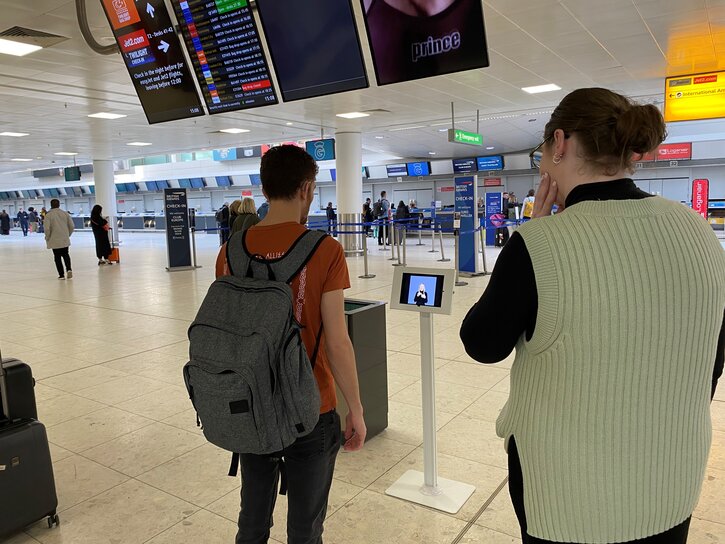
Tech trials at Glasgow
Airports and governments around the world are investing heavily in trying to meet disabled passengers’ requirements for autonomy, flexibility and choice. In the UK, one airport leading the way is Glasgow, which in 2023 handled approximately 120,000 passengers with reduced mobility, a number that has been increasing year-on-year. Earlier in 2024, Glasgow Airport hosted a set of accessibility technology trials in collaboration with Connected Places Catapult – the UK’s innovation accelerator. The trials were carried out in March as part of the Connected Airport Living Lab program.
The technologies on trial included Gazooky Studios’ instant messaging service ChapARone, Hello Lamp Post and its AI digital assistants, Signapse and its AI-powered automatic sign language announcement technology, and Signly and its sign language translation solution.
“It was a great learning opportunity, and we are set to launch a report soon detailing all our findings,” says Andrew Chadwick, interim ecosystem director of air mobility and airports at Connected Places Catapult. “The report will provide insights from passengers with lived experience in using the technology that was deployed. It will also provide principles that can be used by other airports and innovators to make sure the solutions can meet the needs of deaf and neurodivergent passengers.”
Chadwick notes that Connected Places Catapult is interested in working with other airports or airlines to test innovative technologies that can benefit disabled passengers. “By doing this more we can get a better understanding of how to design solutions and how best to deploy them,” he says.
“Air travel is, and should always be, for everyone”
Paul Scott, Glasgow Airport
Glasgow’s work with Connected Places Catapult is the latest in a string of initiatives the airport has undertaken to better support disabled passengers in the airport environment. “We have also rolled out AvTech Connect and PRM Assist technologies, which both support disabled passengers,” explains Paul Scott, terminal assurance manager at Glasgow Airport.
PRM Assist enables passengers to book assistance directly with the airport and tailor their needs if they are having difficulty booking elsewhere. AvTech, meanwhile, uses GPS and Bluetooth beacon technology to collect location data from 140 transmitters installed across the terminal to provide accurate, real-time insight to improve performance and deliver superior customer experience. “It’s essentially satellite technology that allows us to track all our PRM staff and deploy them better wherever they are needed across the terminal,” Scott explains.
“It can, for example, be used to organize welfare checks on hearing impaired passengers who could miss gate calls, changes to gates or delays. We introduced this bespoke addition after a passenger with mobility issues was left at a gate for three hours at another UK airport,” he adds.
ODO’s Van Horn also highlights how a pilot ‘speech to text’ program at gates at Minneapolis-St Paul International Airport is providing similar support to hearing-impaired passengers. “The program provides all announcements on a separate screen and at a very high rate of accuracy thanks to AI,” she explains.
Regarding other technologies that can benefit disabled passengers, she continues, “For people with vision loss for whom wayfinding is the biggest obstacle, there are a growing number of apps that make use of geolocation to orient the traveler. Some, such as Aira, use the camera on a customer’s smartphone or tablet to send a video feed to a remote agent who then provides directions. Aira is now offered free of charge by more than 55 airports in North America.”
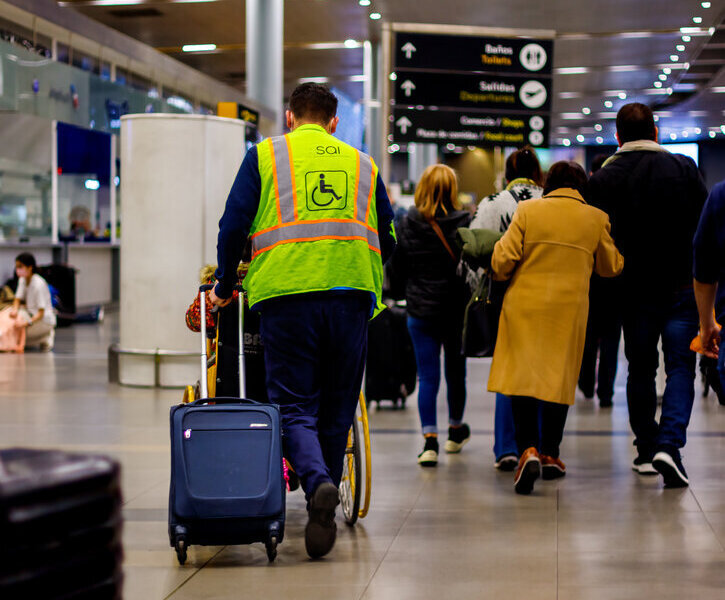
Collaboration and communication
Glasgow’s Scott believes that technologies like these, and the increased support given to disabled passengers, are encouraging more PRMs to travel. “Air travel is, and should always be, for everyone,” Scott says. “Here at Glasgow we are doing everything we can to ensure we support every passenger.”
According to Scott, collaboration and communication are essential when it comes to meeting the needs of disabled passengers. “We are in constant contact with our support groups and local access panels and have strong relationships with each of them. We also undertake continual engagement with the disabled passengers themselves. For example, we were once approached by a visually impaired passenger called Tom Forsyth, who had designed something he called a Ramble Tag [a lightweight harness, designed to be worn on the arm of a guide, for assisted walking]. It was such a simple and fantastic idea that we purchased some of the initial prototypes and incorporated them into our service. We were the first airport to do so, and the Ramble Tags are still used today. Many other airports and train stations have now also picked them up. This is a brilliant example of listening to a passenger’s needs and learning from them to help others,” Scott explains.
Another airport committed to meeting the needs of every traveler through universal accessibility is Alicante-Elche Miguel Hernández Airport in Spain. The airport is currently the fifth busiest in Aena’s network of 46 airports in Spain and third busiest in terms of PRM, handling 207,000 assistances in 2023. This number is growing every year, according to Belén Gisbert Sánchez, head of accessibility at the airport.
In recent months the airport has invested in accessible corridors in the baggage claim hall, accessible parking spaces for electric cars, toilets to meet the needs of ostomy passengers, a sensory room and familiarization videos on airport processes for passengers with hidden disabilities, a new interpreter guide access procedure for deaf and blind passengers, and new signage for PRMs, among other things.
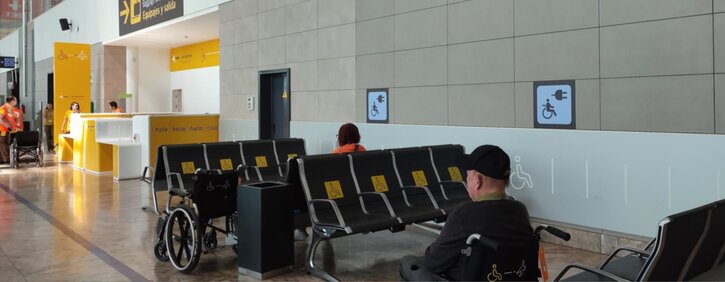
“In Alicante, we are committed to ensuring that all disabled passengers can carry out airport processes independently if they wish to do so,” comments Sánchez. “Technology plays an important role here. We have a guidance system for inside the terminal, for example, which is available in the Aena app. Within this, there is an option to choose accessible routes through the airport, and there are also various ways to request assistance. We are currently working to improve our website and app to inform passengers prior to their flight of the PRM services available within the airport.”
Information and communication are key for accessibility, according to Sánchez, for both disabled passengers and staff. “Passengers with special needs must be given all the information they need to travel – such as how to request assistance and what time they should arrive at the airport – as early as possible so they can prepare. Meanwhile, airport and airline staff must be trained in accessibility and best practices in terms of communication with passengers with special needs and updated with all the latest developments available in accessibility.
“Mobility devices are extensions of their owners’ bodies, not luggage”
Stephanie Cadieux, Government of Canada
“Collaboration between all those involved in the different airport processes is also vital to ensure accessibility for all,” she continues. “We hold regular operational follow-up meetings with stakeholders and review any incidents thoroughly. We also work closely with the local community, such as with CERMI – the Spanish Committee of Representatives of Persons with Disabilities – and other associations, and we consult with them about any new projects we are going to develop. In 2023, the CERMI of the Valencian Community awarded us the CERMI prize in the category of Universal Accessibility for our work and constant improvement in this area.”
Sánchez notes that designing and implementing enhanced accessibility into an airport does not have to mean big projects with big investments. “Any improvement, no matter how small, can make a big different to a disabled passenger,” she says. “The most important thing is to look at the day-to-day needs of people with special needs and find a way to meet these within the airport environment,” Sánchez concludes.
Stephanie Cadieux, chief accessibility officer at the Government of Canada, who is a wheelchair user, notes that Alicante-Elche Miguel Hernández Airport’s accessibility efforts are “very encouraging”, and agrees with Sánchez that meeting the needs of disabled passengers is all about providing the right service.
“It’s so important that staff just ask passengers what their needs are, and not assume or ignore them,” says Cadieux. “People with disabilities are passengers, not problems, and mobility devices are extensions of their owners’ body, not luggage. How people and their needs are perceived and treated makes all the difference,” she concludes.
This article originally appeared in the June 2024 issue of Passenger Terminal World. To view the magazine in full, click here.
